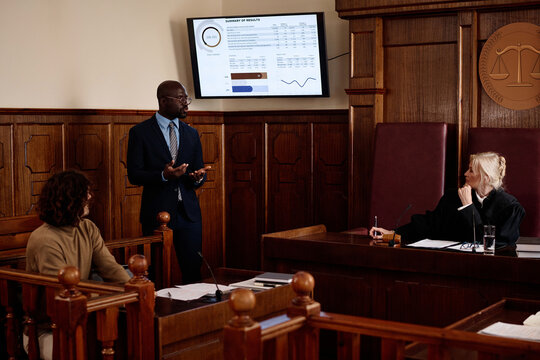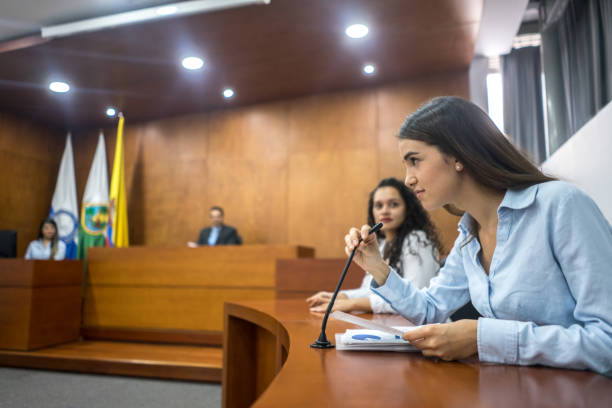Top Techniques for Producing Impactful Trial Presentations in Courtroom Setups
Top Techniques for Producing Impactful Trial Presentations in Courtroom Setups
Blog Article
Exactly How to Produce Involving Trial Presentations That Sway Juries and Judges
Crafting engaging test discussions that mesmerize judges and juries is a nuanced art that requires a tactical method. From the cautious consideration of the audience's expectations to the seamless integration of narration strategies, each component plays a critical duty fit the result of a legal instance - Trial Presentations. By using ingenious visual tools, incorporating interactive components, and committing time to rigorous practice and rehearsal, lawful specialists can significantly boost the impact of their courtroom presentations. The capacity to persuade and involve with well-crafted presentations is a skill that can make all the distinction in swaying a jury or court, eventually tipping the scales of justice in one's support.
Comprehending Your Target Market
To successfully engage your audience throughout trial discussions, it is important to understand their preferences, assumptions, and level of expertise in the topic. By tailoring your presentation to fulfill the particular demands of the audience, you can improve their understanding and retention of the information provided.
Begin by looking into the demographics of the audience, such as age, education and learning degree, and occupation. This info can help you evaluate their experience with legal treatments and readjust your presentation style as necessary. A jury may need less complex language and even more visual aids compared to a team of lawful specialists.
Furthermore, think about the psychological and emotional elements of your audience. Are they thoughtful towards certain arguments or more inclined towards truths and proof? Recognizing these subtleties can aid you mount your discussion in a manner that resonates with the audience on a deeper level.
Storytelling Techniques
Understanding your audience's expectations and choices can significantly influence the effectiveness of your trial discussions, specifically when implementing narration strategies to persuade and astound. Storytelling is an effective device that can aid legal representatives attach with courts and courts on a more emotional degree, making complex legal debates a lot more relatable and remarkable.

Integrating vibrant details, individual narratives, and rhetorical devices can better improve the storytelling experience, maintaining the target market spent and engaged in the end result of the situation. By crafting an influential tale that reverberates with the values and feelings of the jury and judges, legal representatives can boost the chances of winning their debates and accomplishing favorable judgments.
Visual Discussion Tools
Utilizing aesthetic presentation devices can significantly enhance the effect and effectiveness of test presentations by giving a visually interesting method to share complicated details to juries and courts. Visual help such as charts, animations, charts, and diagrams can aid simplify elaborate information, making them much more reasonable and obtainable to the audience. By integrating aesthetic elements into test discussions, lawyers can develop a compelling story that resonates with jurors and leaves a long-term perception.

Incorporating Interactive Aspects
Integrating interactive aspects into trial presentations can improve audience interaction and understanding, cultivating an extra interactive and immersive court room experience. By integrating components such as interactive timelines, 3D computer animations, clickable displays, and virtual truth reconstructions, lawyers can mesmerize jurors and courts, making complex information much more obtainable and remarkable.
Interactive timelines enable my latest blog post for a vibrant display of chronological occasions, aiding the target market comprehend the series of crucial events in a case. 3D animations can bring criminal activity scenes or accident restorations to life, using a thorough graph that helps in making clear elaborate information. Clickable exhibits make it possible for individuals to interact with evidence, records, or images, permitting a hands-on expedition of critical information.
In addition, online reality repairs can transport the audience into the heart of the activity, providing an engaging point of view that conventional discussions might lack. These interactive elements not just engage the visitors yet additionally encourage them to actively take part in the test proceedings, resulting in an extra impactful and influential courtroom discussion.
Practice and Rehearsal
To properly utilize the capacity of interactive components in test presentations, complete method and wedding rehearsal are important to make certain seamless integration and shipment in the courtroom setup. Technique and practice session assistance trial presenters come to be familiar with the web content, timing, and flow of their presentations, permitting them to confidently browse through different aspects such as videos, computer animations, or interactive graphics. By practicing their distribution, presenters can fine-tune their talking skills, body language, and overall presentation style to improve persuasion and trustworthiness before the jury and court.
Throughout practice, presenters can identify any type of technical issues that might emerge with interactive elements, guaranteeing that whatever runs efficiently throughout the real test. In addition, rehearsing before a mock target market or coworkers can provide valuable feedback on the performance of the interactive elements and the general discussion. This comments allows speakers to make needed changes and improvements prior to entering the court room, eventually boosting the influence and success of their trial discussions.
Final Thought
In final thought, developing engaging trial discussions that captivate courts and courts calls for a deep understanding of the target market, effective storytelling techniques, aesthetic devices, interactive components, and complete informative post practice (Trial Presentations). By executing these methods, lawyers can properly convey their arguments and proof in a compelling fashion that reverberates with the decision-makers in the court
Using aesthetic discussion devices can substantially boost the influence and performance of trial discussions by providing a visually appealing method to share complex details to courts and judges. By including visual elements right into test presentations, legal representatives can develop a compelling story that resonates with jurors and leaves a long-term perception.
One popular aesthetic presentation tool is the usage of multimedia presentations, which enable for the integration of videos, pictures, and audio recordings to supplement spoken disagreements. Trial linked here Presentations.To effectively take advantage of the possibility of interactive elements in trial discussions, detailed technique and rehearsal are essential to guarantee seamless integration and delivery in the court room setup. Technique and practice session aid test speakers come to be familiar with the content, timing, and circulation of their discussions, permitting them to confidently browse through various elements such as video clips, computer animations, or interactive graphics
Report this page